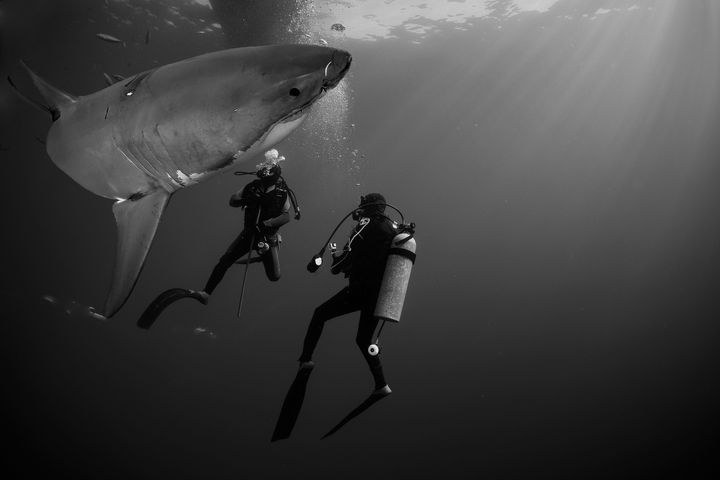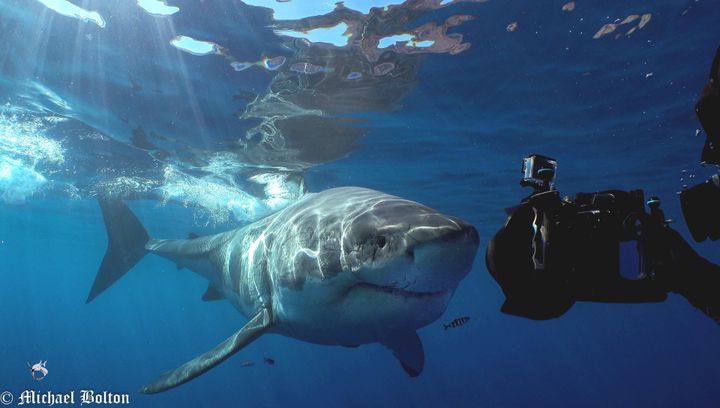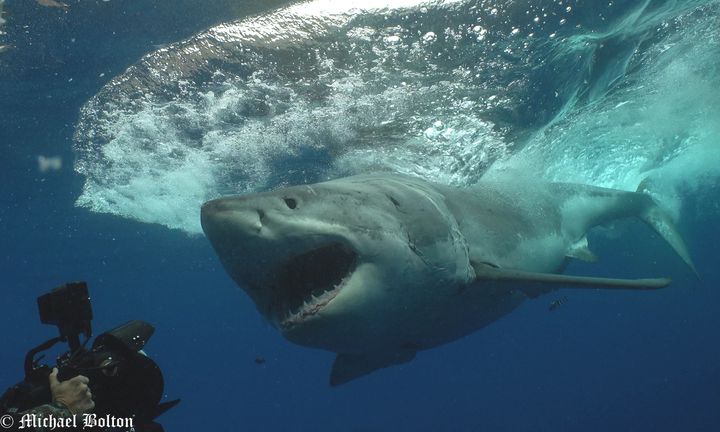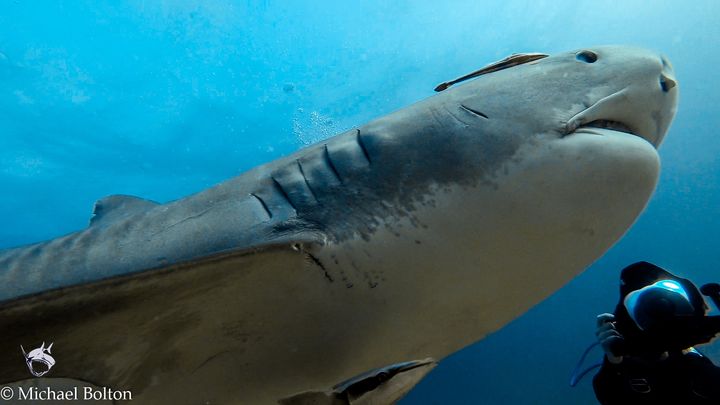
I know what you might be thinking: did that shark attack them?
The answer is no.
This is actually one of the photos from the countless shark dive expeditions Michael Bolton has filmed and photographed.

Michael has been diving with sharks for over 50 years.

He’s been documenting them through photography and videography during his expeditions, and has captured some truly beautiful photos and videos.

These photos and videos show a different side of sharks, one that Hollywood and much of the media doesn’t show.

Adam: What life events led you to become an underwater videographer and photographer of Great White Sharks?
Michael: I started my diving carrier in 1960 at the age of 17. I grew up during the era with TV episodes of Mike Nelson’s Sea Hunt. Watching that show inspired the dream in me to pursue diving. When I was in the air force and transferred to Panama, the opportunity of diving came to light and I jumped on it immediately. I still live in Panama to this day, where we have two oceans dividing the Isthmus - the Pacific and the Atlantic.
After getting into diving, I took up spearfishing soon after. Later, I went on to represent the country of Panama in international spearfishing tournaments during the late 60s and early 70s. In the mid-70s, I was asked to assist in constructing a sport fishing club on Coiba Island, one of Panama’s remote islands off the Pacific. I lived there for almost two years and during that time I drifted away from spearfishing, taking up underwater photography and videography instead. There were many species of sharks to film, and sharks were (and still are) my favorite subject!

My dream of getting into the water to film the Great White Shark was brought about from a documentary shot during the early 70s called Blue Water, White Death. It was Produced and Directed by Peter Gimbel, together with the famous pioneers of shark diving - Ron & Valerie Taylor and Stan Waterman. This is what I’ve always wanted to do, but here in Panama’s waters there weren’t any Great Whites. Using the old Nikon Nikonos 1 & ll, 35m still cameras and a Kodak K100 16mm movie camera with a Al Giddings Underwater housing, I fell into the passion of taking pictures and videos. It was a challenge in those days as it was only film shooting with the old Ektachrome 64 and 100. I was capturing the videos and pictures as best as I could, and then I’d take them to develop and hopefully come out with something worth looking at at. During the next few years I had the opportunity to work with ABC’s Wild World of Sports, filming underwater action shots of sailfish marlin and game fish. It was not a full time gig, it was only when they would come to Panama for these episodes and look me up for the job. I did this as a hobby, not as a profession. I had my full time job so I was only able to do this on my spare time.
Now, how I got into video-graphing and photographing Great White Sharks...
Over the next three decades, I continued to dive whenever possible. After my retirement in 2008, I had the opportunity to join a friend for an expedition and dive to Guadalupe Island off the coast of Baja California at the home of the Great White Shark. Then and there, I anxiously picked up my passion again for underwater photography and videography. Mostly, I turned to shooting video, as I think one has to decide on which way to go. It is hard to concentrate on both at the same time. Although now the new GoPro action cameras have given us the opportunity to add these onto a still camera housing and shoot video while shooting stills, which many cameraman do, including myself. Since this trip to Guadalupe in 2008, I have been back thirteen times over the past nine years.During these past years, I also made shark dives in the Bahamas with Tigers, Hammerheads and Oceanic White Tips, which I also love to shoot, but Great Whites are definitely my favorite!
Adam: Many people fear sharks and think they're out to eat people...what's been your experience and relationship with these majestic creatures?
Michael: Sharks are definitely not here to eat people. I have been diving amongst sharks for over 50 years and have had almost no dangerous encounters with them. I believe most people are afraid because they grew up around the Jaws movie era, and the media created fear amongst people about sharks. This, along with the lack of knowledge and education about sharks and their behavior, have played a big roIl with this mainstream fear.
Even when I began to dive and spearfish, I was taught to be afraid of sharks. I was taught that they were dangerous. Of course, when one is spearing fish and blood is in the water, that's going to make the situation different. Underwater, we are in their world and the shark will come after a bleeding struggling prey. So under these circumstances, it increases the danger of being accidentally bitten or attacked by a shark. Understanding shark behavior, learning more about them, and educating people about sharks is part of the solution, along with creating awareness about their importance to our ecosystem, and informing people that they are NOT out there to eat us!
I photograph and film many different species of sharks in their natural environment and they are an inquisitive, graceful predator that shows no interest in eating us humans. Of course, there can be an exception, as sharks are predators, and even like our friends, the dog, they can have a different temperament. Again, knowledge and understanding shark behavior when diving with them is always the number one solution to protect yourself. Knowing your surroundings, being more watchful during early morning and evening dives, and being aware if there is bait or mammals like seals around you that sharks feed on are all important safety factors when getting in the water with them. I can definitely say that I am more afraid of diving in a sea without sharks than diving with sharks!
Adam: Do you photograph and video the sharks from a cage? Are you swimming with them? Have you ever swam with Great Whites without a cage? If so, what was the experience like?

Michael: I do shoot outside the cage with most of the species - Tigers, Bulls, Hammerheads and Oceanic White Tip sharks. The only shark that we film from inside the cage is the Great White. Although, I have dived outside the cage with the Great Whites; those moments have been the highlights of my life. Great Whites are very curious animals, and even though they knows their size and power, they are also very cautious, intelligent, and have extraordinary eye sight. The Great White doesn’t just run in and attack a prey at the first site. It studies and analyzes what could be a prey by making several circles and assessing the situation before an attack. So, 99% of the time around humans, the Great White is just surveying the situation by circling around until it eventually realizes that we are not its prey. Again, knowledge and understand of sharks behavior is always the best defense with them. Like a non-friendly (hostile) dog, you would never want to turn your back and run from them, as it makes the situation worse. The Great White is an ambush predator, so it could make the situation worse. Outside the cage, the Great Whites act more cautious, and for getting good camera shots, it is much better from the cage. From here, they are much more active and inquisitive, coming in closer.
Adam: What have you learned from your time being with Great White sharks?
Michael: All I can say is the majestic presence of them and just being in the water with them, observing their behavior and seeing how graceful and smart they are. When I see a diver look upon a Great White for the first time, it is always a thrill for me to see their reaction. The awe that is on their face and hearing their experience after seeing them is priceless. Many of these divers have been in the water with many different sharks, but not the Great White, and it brings awe to them almost all the time. I never get tired of seeing them and being able to return to an area year after year where we also get to ID many of the sharks that I’ve seen over the past nine years. I feel like sometimes they look into my eyes and seem to remember me. These experiences really show me that they are not the man eating animal that we were taught to believe.
5) How does your family and friends feel about you doing what you do?

In the beginning when I dedicated my passion was camera shooting sharks, my family and friends were a bit concerned and many thought I was crazy to do this...and some still think that! But, I have recruited some of my friends to participate in these shark dives with me, and this has changed their outlook on the sharks. In return, they have educated others about shark conservation and saving sharks, realizing what they were taught is not the truth about this animal. My wife Becky has joined me now on almost all my dives and shoots doing topside video of the shark action and the trips. My daughter Paola went with me this past year to dive with the Great White in Guadalupe Island and now she is also addicted! In awe, she tells me, “Dad now I understand your passion!”
Adam: If the sharks you've been with had a message to share with humanity, what would they say?

Michael: I am not your enemy nor are you my prey. Please learn to understand and know me. I have been around for over 400 million years and have survived all this time while other species have perished, so I must be worth a lot to the survival of the planet and the oceans. Think about this! My fins are not what many may think. They are tasteless and mostly only eaten by some humans as a "status" meal, or a myth that they have some magical power! We are killed only for this reason and our fins are cut off, and then we are left to drown to death on the ocean floor. Who is the dangerous predator now?
Adam: What are your top 3 shark stories?
Michael: Wow this is a hard one, as there are so many stories. I was with a Tiger shark in the Bahamas and was able to gently hold down her head and put her into a state tonic immobilization.

We were drift diving at around 50-60 ft in 2000 feet of ocean filming Oceanic white tips, with 15-20 sharks circling around us and bumping off our cameras and tanks with their curious and beautiful behavior. It was a non-stop action experience. Diving outside the cage with Great Whites and being involved in tagging and extracting biopsies for study and migration habits are other highlights that come to mind.
In 2015, I captured a picture of a female juvenile great white off Guadalupe Island. I noticed she was a new shark to the area and I sent in her picture for ID confirmation to the MCSI, Marine Conservation Science Institute. They keep a registration ID book of over 200 great whites that return to the area of Guadalupe Island every year during the months of July-December. She was confirmed as a new shark to the area and I got credit for her pictures, as well as having the opportunity to name her for the ID book and future updates. I named her Mikaela Victoria, after my granddaughter.
In 2016, during three different trips to Guadalupe Island during October and November, I saw her on every trip. On one trip I was filming her alone from inside a cage where I laid down and she gently turned to me and swam straight to the cage where she stuck her nose inside , like to say hello happy to have the name Mikaela Victoria, it was amazing! She was so gentle at this moment.
On another 2016 trip to Guadalupe, we saw a Great White with a large barnacle encrusted rope tangled and dragging around its body. It was a heavy weight on him and it was eating away at his skin. It looked like it had been there for some time. We could see that he was not eating well as he was very thin. Anyway, after studying the situation and figuring out what to do, we were able to cut him free. Relieving him of this burden was an enlightening experience for all of us involved in this rescue mission.
Adam: Where are your favorite places to dive and document sharks? And why?

Michael: Guadalupe Island Mexico and the Islands of the Bahamas, mostly because of the clarity of the water and the abundance of shark species that we get to study and film.
Adam: What're the greatest lessons you learned from sharks?

Michael: Many, but the most important I believe is to respect, teach and conserve more of our ocean environment. Without the shark, our seas and oceans will lose balance, causing our ecosystem to crumble.
Adam: What're the gifts that you ultimately want to leave the world with?

Michael: That sharks are part of our Earth and ecosystem and they MUST be protected for generations to come. I hope that my video footages and pictures will continue to be looked at in a positive way and I hope that they can be used to educate our current and future generations.
Were you fascinated by this interview? If so...you can connect with Michael through the links below:
If you’re interested in experiencing the beautiful world of sharks with Michael and other world-renowned shark experts, you can join them this October 2017:

